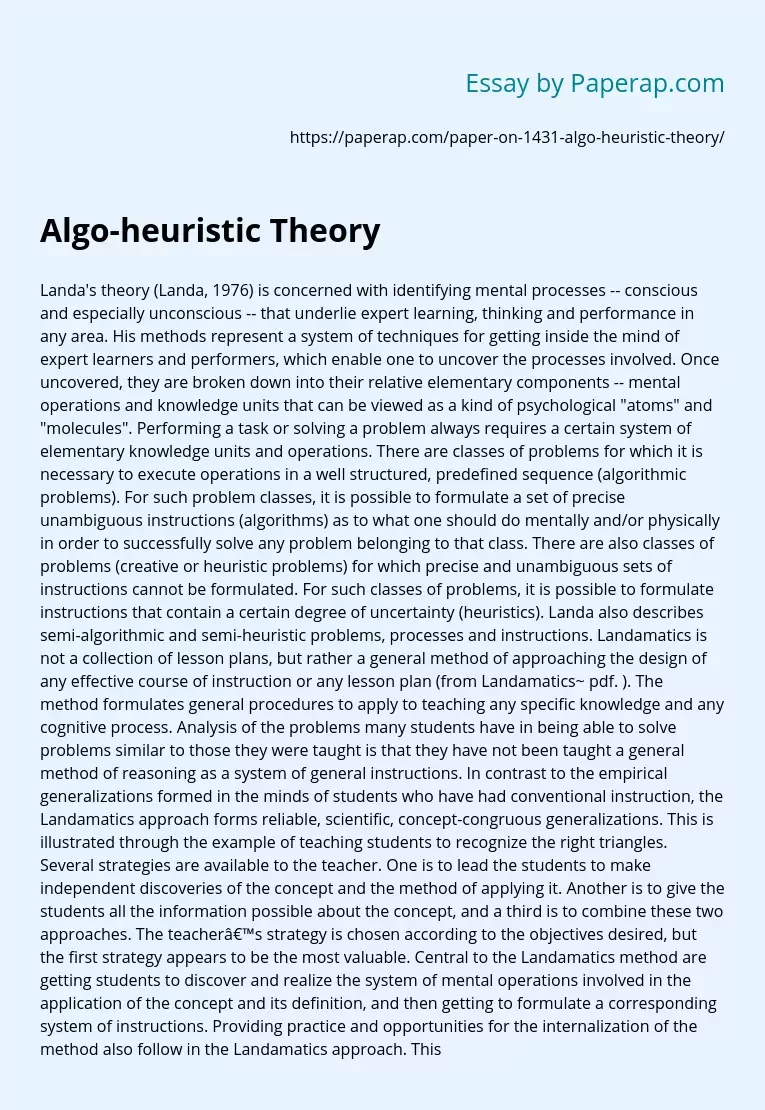Teaching Method Algo-Heuristic Theory
Landa’s theory (Landa, 1976) is concerned with identifying mental processes — conscious and especially unconscious — that underlie expert learning, thinking and performance in any area. His methods represent a system of techniques for getting inside the mind of expert learners and performers, which enable one to uncover the processes involved. Once uncovered, they are broken down into their relative elementary components — mental operations and knowledge units that can be viewed as a kind of psychological “atoms” and “molecules”.
Performing a task or solving a problem always requires a certain system of elementary knowledge units and operations.
There are classes of problems for which it is necessary to execute operations in a well structured, predefined sequence (algorithmic problems). For such problem classes, it is possible to formulate a set of precise unambiguous instructions (algorithms) as to what one should do mentally and/or physically in order to successfully solve any problem belonging to that class. There are also classes of problems (creative or heuristic problems) for which precise and unambiguous sets of instructions cannot be formulated.
For such classes of problems, it is possible to formulate instructions that contain a certain degree of uncertainty (heuristics). Landa also describes semi-algorithmic and semi-heuristic problems, processes and instructions. Landamatics is not a collection of lesson plans, but rather a general method of approaching the design of any effective course of instruction or any lesson plan (from Landamatics~ pdf. ). The method formulates general procedures to apply to teaching any specific knowledge and any cognitive process.
Analysis of the problems many students have in being able to solve problems similar to those they were taught is that they have not been taught a general method of reasoning as a system of general instructions.
In contrast to the empirical generalizations formed in the minds of students who have had conventional instruction, the Landamatics approach forms reliable, scientific, concept-congruous generalizations. This is illustrated through the example of teaching students to recognize the right triangles. Several strategies are available to the teacher.
One is to lead the students to make independent discoveries of the concept and the method of applying it. Another is to give the students all the information possible about the concept, and a third is to combine these two approaches. The teacher’s strategy is chosen according to the objectives desired, but the first strategy appears to be the most valuable. Central to the Landamatics method are getting students to discover and realize the system of mental operations involved in the application of the concept and its definition, and then getting to formulate a corresponding system of instructions.
Providing practice and opportunities for the internalization of the method also follow in the Landamatics approach. This will bring about automatization of the mental operations of the method. Generalizations of this approach through several forms result in a method that can be applied to concepts with different logical structures of their characteristics features. The first studies of the author and his associates were focused on thinking process and methods involved in knowledge application, i. e. , were studies of methods of applying knowledge.
Three things, however, soon became clear. First that methods of thinking are a particular case of a more general methods of cognitive activity which include methods of perception, methods of memorization and some others. Second, that methods of thinking are not limited to the methods of applying knowledge but include methods of acquiring knowledge as well or, stated more generally, methods of learning. Third, that learning methods of knowledge application enormously affects the process of knowledge acquisition making it vastly more effective.
The reason for this is simple: people don’t learn knowledge just by listening to or reading the explanations (unless, of course, their aim is just mere familiarization with some knowledge). They learn it by applying it to solving problems, which is one of the main purposes of the process of practicing. If this is so, then it becomes apparent why effective methods of knowledge application make the instruction, the knowledge application process becomes an important component of the process of knowledge acquisition.
After the first studies had been conducted, it also became clear that teaching methods of cognitive activity affects not only the processes of learning and thinking but leads to the formation of certain qualities of mind and personality traits — such, for example, as intelligence, intuition, self-management, self-regulation and self-control, good organization of mind, a higher level of confidence in the ability to learn and solve problems, and such personality traits as systematicity in approaching problems, thinking of possible strategies for attacking problems and analyzing them before trying to actually solve the, and some others.
Teaching Method Algo-Heuristic Theory. (2017, May 30). Retrieved from https://paperap.com/paper-on-1431-algo-heuristic-theory/

